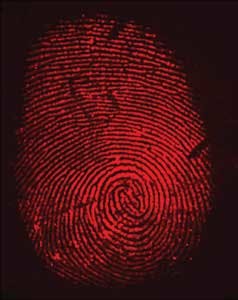Fluorescence reveals drug use from fingerprint testing
The world's first prototype of a handheld fingerprint drug-testing device has been developed by University of East Anglia spin-out company Intelligent Fingerprinting (Norwich, UK;www.intelligentfingerprinting.com).
The device detects drugs and other substances from the sweat contained in fingerprints and will enable mobile testing with instant results.
Intelligent Fingerprinting—based in the NRP Innovation Centre at Norwich Research Park—developed the prototype with eg technology (Cambridge, UK;www.egtechnology.co.uk), a product design, development, and engineering consultancy.
The Intelligent Fingerprinting system first captures an image of the fingerprint taken from an individual on a 2-MpixelCMOS sensor, creating a record for later comparison. Then the fingerprint is treated using an aqueous solution of nanoparticle antibody conjugates that can bind to metabolites—small molecules produced by the body as a result of the metabolism of a particular drug—on the fingerprint.
Finally, the excess unbound antibody conjugates are removed, and although it is possible to view the results of the analysis with white light, the fingerprint is further developed by a second application of another antibody that is coupled to afluorescent dye.
The imager captures a second image of the fingerprint with the fluorescent dye bound to the metabolite antibody conjugates. This can be used to identify the owner of the mark through comparison with the original image.
The device compares the images as a check to ensure that it is detecting the drug metabolites in association with the structure of the individual's fingerprint. This is important since it ensures that a false positive is not reported, as might be the case where the tested individual might have innocently picked up someone else's metabolites by shaking hands.
The images show that the detected metabolites are released from the individual sweat pores before spreading down the ridges to create the fingerprint image. The link of the detected metabolites to the pore structure within the fingerprints provides evidence that the donor of the fingerprint is associated with the detected metabolite of the substance being investigated.
Presently, the display on the system just provides information as to the progress of each test, and gives a pass/fail result. But the company is looking at ways to export the fingerprint image, either for evidence or to store in current systems that are available for matching fingerprints for police use. The Intelligent Fingerprinting system is scheduled to go into full production in 2012.

